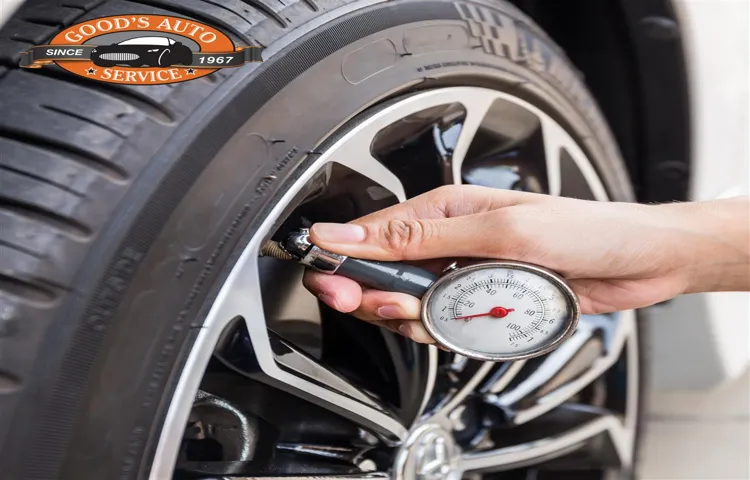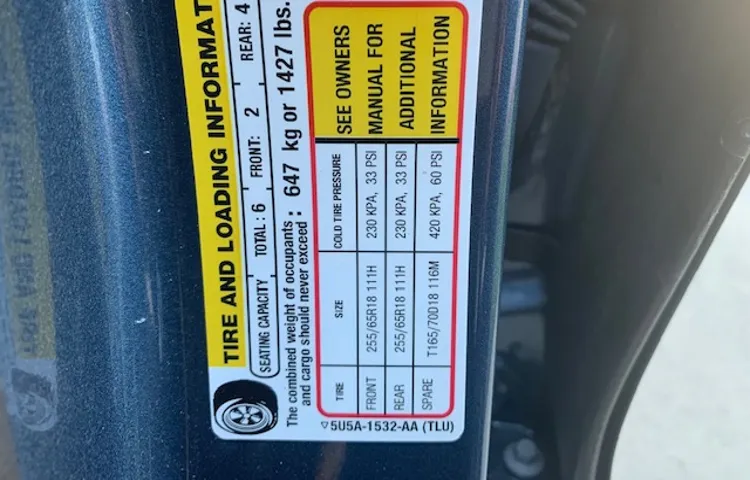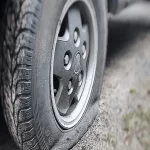Do you know how often you should be checking your tire pressure? It’s a small detail that can make a big difference in your car’s performance and your safety. Checking your tire pressure regularly can help you avoid accidents, save money on gas, and prolong the life of your tires. But how often is “regularly?” The answer can vary depending on several factors.
In this blog post, we’ll explore how frequently you should be monitoring your tire pressure and why it’s essential to do so. So, buckle up and let’s dive into the world of tire pressure!
Table of Contents
Why Tire Pressure Matters
One of the most important aspects of maintaining your car’s overall health is keeping its tire pressure in check. In fact, having the correct tire pressure can not only extend the lifespan of your tires, but it can also improve your fuel efficiency and enhance your car’s overall performance. So, how many times should you check your tire pressure in a month? The general rule of thumb is to check your tire pressure at least once a month.
However, it’s also important to keep an eye on your tires after changes in weather or long journeys, as these can affect the pressure inside your tires. The good news is that checking your tire pressure is a rather simple process that can be done in a matter of minutes with a tire pressure gauge. It’s always better to be proactive than reactive when it comes to this crucial aspect of car maintenance, as maintaining the ideal tire pressure can save you time, money, and most importantly, keep you safe on the road.
Decreased fuel efficiency
Maintaining the correct tire pressure is essential for maximizing fuel efficiency. Inflating tires to the recommended pressure level ensures that the car is operating at its most efficient level. If tire pressure is low, the tire will have an increased surface area in contact with the road, creating more friction and resistance, and causing the engine to work harder, decreasing fuel efficiency.
On the other hand, if the tire pressure is too high, the tire’s contact area will be lessened, leading to increased wear on the center of the tire and decreased traction. Additionally, having the right tire pressure also benefits the overall lifespan of the tires and provides a more comfortable and safer driving experience. It’s crucial to check tire pressure regularly, especially before a long journey, to reap these benefits.
So, invest in a tire pressure gauge, and check that pressure levels meet the manufacturer’s recommendations. Your car will thank you for it, and you’ll save on fuel costs in the long run.

Poor handling and performance
Tire pressure is a critical aspect of driving that is often overlooked but has a significant impact on handling and performance. Driving with low tire pressure can lead to poor handling, longer stopping distances, and decreased fuel efficiency. On the other hand, driving with too much air pressure can cause the tires to wear out prematurely, leading to unstable handling and even tire blowouts.
Maintaining the recommended tire pressure not only improves performance and safety but also saves money by prolonging tire life and reducing fuel expenses. So, the next time you hit the road, make sure to check your tire pressure to ensure a smooth and safe ride. Remember, a few minutes of checking will save you from a potential disaster.
Factors that Affect Tire Pressure
How often should you check your tire pressure? Generally, it’s recommended that you check your tire pressure at least once a month. Several factors can affect tire pressure, including temperature, driving habits, and the age of the tires. High temperatures can cause tire pressure to increase, while colder temperatures can cause it to decrease.
Additionally, driving habits, such as braking and accelerating, can affect tire pressure over time. Lastly, as tires age and wear down, they may lose air at a faster rate, so it’s crucial to monitor your tire pressure regularly to ensure safety and optimal performance. By regularly checking your tire pressure, you can prevent costly damage to your car and maintain fuel efficiency.
So, make sure to make it a habit to check your tire pressure at least once a month.
Temperature changes
Temperature changes can significantly affect tire pressure, and it’s important to keep this in mind when you are monitoring your vehicle’s tire pressure. As the temperature drops, the air molecules in your tires contract, causing the air pressure to drop. Conversely, when the temperature rises, the air molecules expand and cause the tire pressure to increase.
This means that during the colder months, your tire pressure might drop, and during the hotter months, it might increase. It’s essential to regularly check your tire pressure and adjust it accordingly to ensure your tires are functioning at their optimal level and to avoid any potential issues on the road. Additionally, ensuring your tires have the proper amount of air pressure can improve fuel efficiency and prolong the life of your tires, saving you money and keeping you safe on your travels.
Driving conditions
When it comes to tire pressure, there are several factors that can affect it, including driving conditions. One of the biggest factors is temperature. As the temperature drops, the air molecules in your tires contract, causing the pressure to decrease.
This is why you may notice your tire pressure warning light come on during the colder months. Other driving conditions, such as altitude and road surface, can also affect your tire pressure. As you drive up to higher altitudes, the air pressure outside of your vehicle decreases, which can cause your tire pressure to increase.
Additionally, rough road surfaces can cause your tires to lose air more quickly than smooth roads. It’s important to regularly check your tire pressure and adjust as necessary to ensure optimal safety and performance. By keeping an eye on these factors, you can help prevent tire damage and ensure a smoother ride.
Recommended Frequency for Checking Tire Pressure
As a good practice, it is recommended to check your tire pressure at least once a month. Regularly checking and maintaining proper tire pressure is crucial for your safety and the longevity of your vehicle’s tires. Driving on underinflated tires can cause various issues like decreased fuel efficiency, tire wear, and even a dangerous blowout.
Checking tire pressure is quick and easy, and you can do it yourself with a tire pressure gauge or at a gas station. It’s important to check the pressure when the tires are cold, as driving heats up the tires and can give inaccurate readings. A good tip is to make it a habit and check your tire pressure at the same time every month, such as the first day of every month.
By doing so, you can assure your car’s safety, extend tire life, and ultimately save money on fuel consumption.
At least once a month
When it comes to car maintenance, checking tire pressure is often overlooked. Many people think it’s not that important, but the truth is, it’s crucial for your safety. The recommended frequency for checking tire pressure is at least once a month.
Tire pressure can affect your car’s handling, fuel efficiency, and even your braking distance. Poorly inflated tires are also prone to blowouts, which can lead to accidents on the road. So, it’s essential to keep your tires properly inflated and ensure they have the right amount of pressure.
Checking tire pressure is effortless, and it only takes a few minutes. You can do it yourself with a tire pressure gauge, or you can visit a nearby gas station that offers air pumps. Overall, checking your tire pressure regularly can save you money and prevent potentially dangerous situations on the road.
So, make it a habit to check your tires at least once a month, and you’ll be driving safely and efficiently.
Before long trips
When it comes to preparing for long trips, checking your tire pressure is a crucial task that you should never overlook. Not only does proper tire pressure ensure better fuel efficiency, but it also improves your car’s handling and reduces the risk of accidents. Experts recommend checking your tire pressure at least once a month, but before long trips, you should always double-check for safety’s sake.
Driving long distances, especially with a heavy load, can place extra strain on your tires, causing them to deflate faster than usual. It’s best to use a quality tire pressure gauge to check your tires’ pressure, as relying on visual inspection alone can be inaccurate. Ensure that your tires are inflated to the manufacturer’s recommended pressure level, which you can find in your car’s owner manual or on a sticker located on the driver’s side doorjamb.
Remember, regularly checking tire pressure may seem like a minor task, but it can make a huge difference in your safety and driving experience. So, don’t forget to give your tires a quick check before hitting the road!
After major temperature changes
When the temperature changes drastically, it can affect your tire pressure, which is why it’s essential to check your tire pressure regularly. The recommended frequency for checking your tire pressure is once a month, but it’s especially important to do so after any significant temperature changes. If the temperature drops suddenly, your tires can lose pressure, which can affect your braking distance and overall vehicle stability.
Similarly, if the temperature rises drastically, your tire pressure can increase, which can make your tires more susceptible to blowouts. To stay safe on the road, it’s best to invest in a tire pressure gauge and check your tire pressure frequently, no matter the temperature conditions. By doing so, you can ensure that your tires are properly inflated, which can improve your fuel efficiency, extend the life of your tires, and keep you and your passengers safe while driving.
How to Check Tire Pressure
Checking your tire pressure is a crucial part of vehicle maintenance that is often overlooked. Many people are unsure of how frequently they should check their tire pressure. The recommended frequency for checking tire pressure is once a month, but it is always best to follow the manufacturer’s guidelines.
It is also important to check your tire pressure before any long road trips or if you notice any significant changes in your driving experience such as increased noise or decrease in fuel efficiency. To check your tire pressure, you will need a tire pressure gauge and access to a source of compressed air. Simply remove the valve cap, attach the gauge to the valve stem, and read the pressure.
If the pressure is too low or too high, use the compressed air to inflate or deflate the tire accordingly. Regularly checking your tire pressure will not only improve your vehicle’s performance but also increase your safety on the road.
Step-by-step guide
Checking tire pressure regularly is an essential task that every car owner should perform. Low or high tire pressure can significantly impact your car’s handling and affect your driving safety. So, how do you check your tire pressure? It’s a simple process that you can do on your own, and here is a step-by-step guide.
First, you need to have a tire pressure gauge. Next, remove the valve cap from the tire’s air valve and place the gauge on the valve. You’ll hear a hissing sound, and the gauge will show the tire pressure.
Compare the reading to the recommended level in your car owner’s manual or on the tire information placard typically found in the driver’s doorjamb or glovebox. If the tire pressure is too low or high, add or release air accordingly and recheck the pressure until it’s correct. Repeat the process for all the tires, including the spare.
By following these simple steps regularly, you’ll ensure that your car has the correct tire pressure levels, prolong tire life, save money on fuel, and increase your vehicle’s overall handling and safety.
Tools needed
Checking tire pressure is an important aspect of car maintenance, as it not only keeps you safe on the road, but can also improve your car’s fuel efficiency. To check tire pressure, you will need a few tools, including a tire pressure gauge, a source of compressed air, and a rag or paper towel. Begin by removing the valve cap on the tire and pressing the gauge onto the valve stem.
The gauge should give you a reading of the tire’s pressure, which you can compare with the recommended pressure stated in your car’s manual or on the tire itself. If the pressure is too low, add air using a compressor until you reach the recommended pressure. If the pressure is too high, let some air out until it matches the recommended pressure.
Remember to check the pressure in each tire, including the spare, at least once a month to ensure your safety and the longevity of your tires. Now, go ahead and check your car’s tire pressure today and enjoy a safer, more efficient ride!
Conclusion
As they say, the key to a smooth ride is properly inflated tires. So, how often should you check your tire pressure? The answer is simple: once a month. This ensures that your tires are in top condition, saving you money on fuel and preventing any unexpected blowouts.
Remember, a little bit of effort goes a long way in keeping your tires rolling happily and you cruising smoothly down the road. Happy driving!”
FAQs
What is the recommended frequency for checking tire pressure?
It is recommended to check tire pressure at least once a month.
Can overinflated or underinflated tires affect my vehicle’s performance?
Yes, overinflated or underinflated tires can negatively impact vehicle handling, braking, and fuel efficiency.
What is the correct tire pressure for my vehicle?
The correct tire pressure for your vehicle is typically listed in the owner’s manual or on a sticker inside the driver’s door.
Should I check tire pressure when my tires are hot or cold?
It is recommended to check tire pressure when the tires are cold for the most accurate measurement.
Can tire pressure monitoring systems replace the need for manual tire pressure checks?
While tire pressure monitoring systems can alert you to low tire pressure, they should not replace regular manual tire pressure checks to ensure accurate readings.
What tools do I need to check my tire pressure?
You will need a tire pressure gauge and an air compressor, or access to a gas station air pump.
Can extreme weather conditions affect tire pressure?
Yes, temperature changes and extreme weather conditions can cause fluctuations in tire pressure, so it is important to check them regularly.



